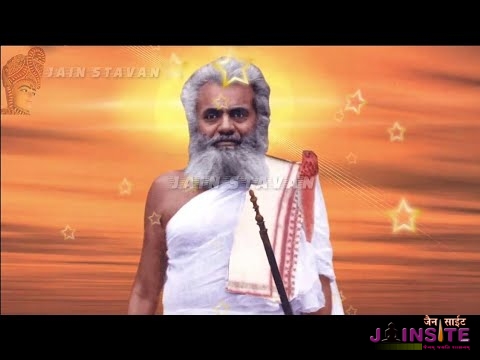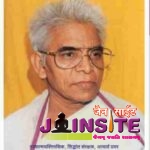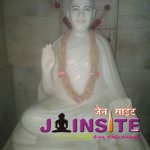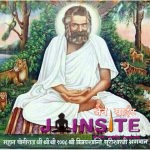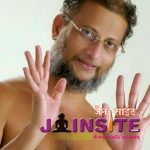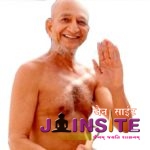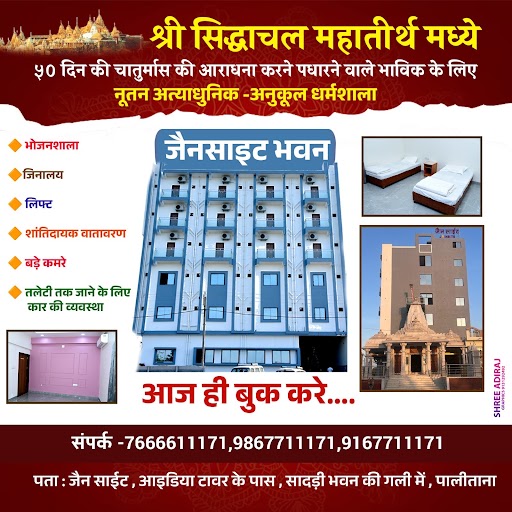Acharya Vijay Nemisuri Maharaj is considered to be one of the ablest Suri Chakravarti of 20th century. He was a sincerest person of Celibacy, his penance-strength was great, he was versatile genius of nature gifted intelligence and his impressive personality was sober. This Acharya has made an era in Jainism; his activities included renunciation of knowledge, protection religious scriptures, writing of new works and their publication as well as maintenance of whole libraries of scriptures, for which he provided guidance. Under his inspiration for the first time in Jain society, the auspicious beginning of publication of Jain literature was made.
The three basic elements of Jain Shashan are: Dev tattva, and Dharma Tattva. ‘Dev’ (Prophet) is he, who shows the path to self-realization or salvation – the element guiding the path (the cult). ‘Guru’ is he, who adopts the path (cult) and shows others how to adopt it. ‘Dharma’ is the path – the cult shown by the Dev (Prophet).
We are indebted to ‘Dev’ for his great benevolence. But in his physical absence the task of keeping that path the Dharma going on continuously lies on the shoulders of the Guru Tattva. An incessant series of such Gurus prevailed in the Shashan of Bhagvan Mahavir. The first and foremost in the series was Bhagavan Sudharma Swami. In the glorious chain of his disciples who succeeded him were dignified Acharyas. These Acharyas on one side kept theMahavir’s path going on continuously and on the other side, they accomplished their own spiritual welfare. Shree Vijay Nemisurishvarji was one of the strongest links in this brilliant series of the Dharmacharyas.
Nemisuri Maharaj was a religious awe-inspiring entity who flourished as a prominent Jain Acharya of the 20th Century of Vikram Samvat (V.S.). To introduce him is like holding a lamp to introduce the sun. He was a self-introduced personality. There would have been hardly any Jain throughout the country who was not aware of his name and fame.
The rarest events pertaining to his birth and death were miraculous. His birth took place in the city of Mahuva on the 1st day of the month of Kartik of the year 1929 V.S. (1872 CE). His death took place on the night of the last day of the last month (Aaso) of the year 2005 V.S. (1948 CE) in the city Mahuva just near the spot of his birth. The mother who gave him birth was Diwalibai by name and the day on which his death took place was Diwali.
Besides these rare events of his life, he possessed multiple splendid qualities and great accomplishments which inspire us to hold him in high esteem. He had such a strong will and desire that he took a major life decision of Diksha (renunciation) at a tender age of 16 by running away from home. He stayed true to his vows throughout his Sadhu life. His life has been a great inspiration and commands respect because of his wonderful qualities and unique accomplishments. Following his Diksha ceremony under the auspices of revered Guru Shri Vruddhichandraji, he strictly followed spotless conduct and by ardent services to his Guru he achieved great blessings from him and became a Jain scholar through tireless studies of Jain scriptures.
Following the death of his Guru, he independently travelled in many places to do service to Jain Shasan in an increasingly re-energised manner. He inspired many worthy bright souls to be his disciples. They also turned out able-servants to the Shasan, dignified scholars and strict followers of the conduct.
His specific accomplishments are described as follows:
-
He founded numerous Jain schools (Pathshalas) all over the state of Gujarat and Rajasthan to spread scholastic knowledge of Jain scriptures and conduct. He also established several Gnanbhandars and libraries to store and protect ancient literature, in religious books.
-
Being merciful, he preached the fishermen in the coastal villages. His preaching was so impressive that thousands of fishermen were moved to give up fishing. He even saved many cattle from going to slaughter houses.
-
He was twice instrumental in raising funds of lakhs of rupees to settle the debt of Panjarapoles. He also encouraged setting of Panjarapoles for old and weakened animals.
-
He inspired renovation of many Tirth-places like Matar, Sherisa, Vamaj, Kaparda and Kadambgiri. Additionally he successfully struggled and met several challenges dealing with the issues of protecting Maha-tirthas, great pilgrimage places like Shatrunjay (Palitana), Girnar(Junagad), Taranga and Samet-shikharji. He guided Anandji-Kalyanji Peddhi in maintaining protecting and renovating the Tirths.
-
He himself composed a number of scholarly books (Granthas) and inspired and mentored his learned disciples to author several additional books. Moreover he got the best volumes of the most celebrated ancient Acharyas like Haribhadrasuri, Hemchandracharya and YashovijayVachak, edited and published for the first time. Thus he became apostle of the activity of advancing and attaining knowledge. It gave an impetus to awakening for learning among Sadhus and Shravakas in the sangha.
-
He revived the traditions of the specific religious rites and ceremonies like Anjan-Shalaka, Siddhchakra-poojan, arihant Maha-poojan which were lost since long, and brought them into practice along with the right method of performing them. This was consistent with the true meaning of Shastras.
-
He also restarted the tradition of Yogodvahan which was forgotten. He thus became the first Tapagachchhiya Acharya who was conferred the three degrees (Padavis) of Gani, Pannyas and Suri with the rites, rituals and ceremony chalked out in the Shastras.
-
He preached to the kings and royalties of many princely states like Bhavnagar Valabhipur, Jesalmer and Udaypur, and inspired them to do good deeds like protection of the Tirth places and compassion for living beings.
-
He settled disputes amicably among different castes, sub-castes and Sanghas in different places through factful arbitration and brought unity and harmony among them.
-
He possessed two strong and rare attributes which he strongly internalized. He was inwardly strong believer and practitioner of celibacy through mind, speech and action and had the special ability to successfully predict events.
-
He was sincere in his own behaviour and a strict disciplinarian in the training of his disciples.
In spite of all this, he was extremely modest and never thought of presenting himself as the best Acharya. He just called himself an ordinary soul who could be compared to a dust-particle of the feet of the great Acharyas of the past. His modesty is well illustrated by the following episode.
He made the Darbars of Kadambgiri free from addictions with great efforts. They formerly indulged in gambling and drinking etc. The Darbars being thus obliged by him considered him their Guru. With a sense of rewarding this obligation, they expressed their desire to do something for him. Considering it a good opportunity, he inspired them to sell some plots of land on the Kadambgiri hill to Anandji Kalyanji Peddhi for renovation of the Tirth.
So the Darbars said, ”Maharaj, we have regard for you. We would give the land to you as a gift with love. We would not like to sell it for money.” Suriji said, ”We, Jain Sadhus do not own land or any property”. The Darbars then quoted the examples of Jagadguru Hirvijaysuriji and said ”that if Acharya had accepted the documents of lease of Shatrunjay Hill given by Badshah Akbar , then why he should not accept the plots on Kadambgiri?”.
In reply to their argument, Suriji said, ”Dear brothers, Shri Hirvijaysuriji was Jagadguru. I am just an ordinary soul before him. I cannot imitate him. I am just like a dust-particle of his feet.” Through his life-time achievements and accomplishments, he made a strong impact in re-energizing and reviving the meaning of Jain Shastras and proper conduct of Jain Shasan. Hence, he is known to the entire Jain Sangh in the true sense.
Life of Shasan Samrat before renunciation (diksha)
Mahuva is a port of Saurashtra – a land of beauty. Shasan Samrat took birth in the family of Laxmichandbhai and Deewaliben on the auspious New Year Day of the year 1929 V.S. He was named Nemchand, as he was born in the scorpion sign of zodiac.
He learnt in a dust-school in the beginning. It was a dust school, because children were taught to write letters of alphabet and numbers with a stick in the dust spread on a wooden board. He studied in a vernacular school for seven years and thereafter in an English school for three years. After his study, he went to share and stock market to learn some trade according to his father’s will. He got himself trained in the firm of Karsan and eventually got the grip in the business. But he soon lost interest in it and deserved to learn Sanskrit and religious Sutras. With the consent of his father, he went to Bhavnagar to study under His Holiness Shri Vruddhichandraji Maharaj.
How Shasan Samrat got diksha
In Bhavnagar, by the grace of Gurubhagavant, he made a good progress in his study. While studying, he used to serve devoutly and jealously his Gurubhagavant as well as other munirajas. He was blessed with constant vicinity of his Gurubhagavant. All these three factors in no time, began to infuse in him the feeling of detachment from worldly life. He said, ”I studied in school, did business and now I am studying here. But what next? Have I to end my life fruitlessly, being lured by worldly passions. What does it mean? On the other hand, I must do some such noble mission (which) as will do good to me as well as others. And that mission is the Monk-hood (Sadhupanu). What a harmless and faultless life!”
The seed of this thought got rooted in his mind and it began to be nurtured as time passed. It was finally well-shaped by the teachings of the Gurubhagavant which were filled up with feeling of detachment. Because of this, he became totally averse to worldly life. It was to such an extent that when his father from Mahuva, wrote to him about the sad demise of his grand-ma, he in reply said, ”This worldly life is meaningless. No one belongs to anyone. so one should be diligent in observing religious activities and that is meaningful.”
Handwriting by Acharya Vijay Nemisuri Maharaj
When father read this, he apprehended that if the boy stayed in Bhavnagar any longer, he would surely turn a Sadhu. So he called him back telling him that he was ill, and then he became more vigilant in watching his activities. On the other side, Nemchandbhai, also grew stronger in his thought. Durlabhjibhai, his friend too was a Mumuksh, – desirous of Diksha. He too didn’t get permission for it. So both the friends planned to run away and when that got the chance, they left home for Bhavnagar and urged Gurubhagavant for Diksha. Gurubhagavant bluntly refused to give them Diksha without permission from their parents.
There was no problem about Durlabhji, as his father had died. So on an auspicious day, he was given Diksha by the Gurumaharaj. Now Nemchandbhai strongly resolved to get Diksha by any means. He approached Maharaj Ratnavijayji and persuaded him to give him a complete dress of Sadhu. When he got it, he put it on in a lone place and presented himself before Gurumaharaj. Gurumaharaj was just amazed. But when he realised his daring, he agreed and gave him Diksha performing ominous ceremony and offered him the ‘Ogho’ which was a sacred heritage of the Gacchapati Shri Mulchandji Maharaj. He was named Muni Nemvijayji. This meritorious event took place on the ominous day- Jeth Sud Satam in the year 1945 V.S (1888 CE).
Pursuit after spiritual life and study of Jain scriptures
After being a Sadhu, Muni Nemvijayji was fully engrossed in observing the daily rites. He devoted himself to Gurubhagavant as well as other senior munivars and assisted and served them with sense of submission as well as zeal and enthusiasm. As a result, he became most beloved of the Gurubhagavant and won his grace. Side by side he imbibed in himself good qualities of a Sadhu, namely flawless observance of ashta-pravachanamata, liking for observing rites, and keen readiness for study.
He had already been well versed in the avashyaka sutras – necessary for a Sadhu, in a very short time. So now in order to begin the study of Vyakarana (grammar) he began to learn, ‘Siddhant-Chandrika’ start with. He read books of poetry like Raghuvansh and Kirat. Then with a view to accomplish the desire of his Guru, he studied the (grammar) Vyakrana named Siddhant-kaumudi. Side by Side he read epics like Magha-Naishadha. While continuing his own study, he also used to teach other Sadhus.
.Having performed the rites of Yogodvahan strictly according to scriputres under Pujya Panyas Shri Pratapvijayji, he got Vadi-Diksha together with other Sadhus.
He returned to Bhavnagar. Gurubhagavant’s health was deteriorating. He became vigilant in nursing him. His study continued. During that time Pujya Danvijayji, a very learned disciple of Pujya Mulchandji, who was an unmatched scholar of Nyayashastra (logic), visited Bhavnagar. He was highly impressed by Nemvijay’s keenness for acquiring knowledge and devotion in observing the rites. He went to Palitana. There he set up ‘Shree Buddhisinhji Jain Sanskrit Pathshala‘. Sadhu and Sadhvi bhagvantas were to be taught Nyaya (logic) and Vyakarana (grammar) there.
When the Pathshala was installed, Pujya Danvijayji wrote to Vruddhichandraji Maharaj that if he sent Nemvijayji to Palitana, he would conduct the Pathshala well and would teach the Sadhu-Sadhvis. Gurubhagvant asked Nemvijay to go to Palitana. He was reluctant to go, looking to the ill-health of Gurubhagavant, yet he honoured his desire and went to Palitana. He conducted the Pathshala very well and his own study under Pujya Danvijayi also went on.
Here in Bhavnagar Gurubhagavant’s condition worsened and at last, on the day of Vaishakh sud Satam, he breathed his last, in deep peace and solemnly uttering the mantra – ‘Arihant Siddha Sahu’. Nemvijayji Maharaj was deeply grieved and shocked by this news. He was so much upset, that he was disinclined to eat or drink. He was more grieved, because could not be beside him during his last moments. But eventually, good sense prevailed upon him, he reconciled, calmed down and firmly resolved to accomplish the desires of the Gurubhagavant for the service to the Shasan. He completed the study of grammar by Siddhahem-shabdanushasan-bruhad Vrutti, and Vyutpattivad. He studied specific works on Nyaya under Pujya Danvijayji Maharaj.
Thereafter he had independent chaturmas. In spite of multiple activities, he learnt many shastras by himself. He also studied many other shastras namely Paribhashendushekhar, Chintamani etc. with the help pandits and scholars. He went through a numbers of Agamshastras, too.
Whatever he studied he firmly imbibed in his mind, because of his great power of memory, intellect and understanding. He initiated the system of Gnan-sadhna and Shastrabhyas, by preparing his disciples in the same manner.
Installation of Shasan-samrat as Gani and Acharya.
Shri Vrudilhichandraji Maharaj had seen merit (worth) in Nemvijayji Maharaj and he had told P. Shri Gambhirvijayji who was his senior-most disciple (senior co-disciple of Shasansamarat) that he should make Nemvijayji, undergo the rituals of Yogodvahan of the Jain Agamas. According to that direction of Gurubhagavant, P. Shri Gambhirvijayji M. Sent leading shravakas to request Nemvijayji to come Bhavnagar; but due to his ill-health, Nemvijayji requested Panyasji Maharaj to come to Ahmedabad. He sent the renowned Shravakas of Ahmedabad to accept the invitation.
Pujya Panyasji Maharaj accepted the request, came to Ahmedabad and stayed in Panjarapole for Chaturmas. It was the year 1957 V.S. (1900 CE) Nemvijayji started the Yogodvahan of Shri Uttaradhyan Sutra etc. In two years, he completed the Yoga of all the Agamas, except Bhagavati Sutra.
The next chaturmas was in Bhavnagar. Pujya Panyasji Maharaj initiated Nemvijayji Maharaj into the yoga of ShriBhagavatisutra. After the chaturmas, they went to Vallabhipur. In the year 1960 V. S. (1903 CE) on the day of Kartak Vad satam, Pujya Panyasji Maharaj offered him Ganipada in the form of his consent for Bhagvatisutra. On the day Magsar Sud Trij, then he was conferred the Panyaspad.
In those days, there was no competent Acharya Maharaj in the Tapa gachha. It was in consideration of the people to install some awe-inspiring Shasan-Prabhavak Sadhu on Acharya-Pada. Pujya Panyasji Maharaj and most senior Munivar Shri Manivijayji Maharaj thought Nemvijayji quite fit for Acharyapada. They presented their idea before the leading dignitaries of the Sangha during the sixth meeting of the Akhil Bhartiya Jain Shwetambar Murtipujak Conference held in Bhavnagar in the year 1964 V.S. (1907 CE) They accepted this proposal with great joy and requested Pujya Panyasji Maharaj to confer Acharyapada to Nemvijayji Maharaj. He there on initiated Nemvijayji in the Oli (ritual) of Surimantra Panch-Prasthan.
On the day of Jeth Sud Pancham in the year 1964 V.S.(1907 CE) with unprecedented pomp and celebrations, Pujya Panyas Shri Gambhirvijayji Maharaj with his sacred hand, he was bestowed Acharyapada. On that day, Nemvijayji became the very first Acharya among the existing Samvegi Tapagachhiya Munirajas all over Bharat, who received Acharyapada after undergoing Yoyodvahan according to the Shastras. He was now procaimed as Acharya Maharaj Vijay Nemsuriji. He became Shasan Samrat – a leader of the whole Tapa gachha.
Marble image depicting Acharya Vijay Nemisuri Maharaj
The regions where Shasan Samrat stayed and worked
The main places where Shasan Samrat stayed and worked were mostly Ahmedabad, Saurashtra and Khambhat. Among these places, Ahmedabad remained the most prominent. But of all the chaturmasas, the number of chaturmasa spent in Ahmedabad was 18. The Jinalayas and other religious places set-up here and there during his stay in Ahmedabad stand a testimony to his all-pervading influence.
Saurashtra, his motherland was very dear to him. Kadmbagiri Tirth in it was the most-beloved, because he had got it renovated it with great efforts. Besides this, he moved in places like Bhavnagar, Mahuva, Talaja, Jesar, Vallabhipur, Palitana, Botad and Vadhhvan and made the young and the old – all religious-minded. Even today the Shravakas of Gohilwad express their devotion and service to Sadhu-Sadhvis of all the four Jain-Firkas impartially.
This is the result of the preachings of the Shasan-samrat and the Sadhu-Sadhvis belonging to his Samuday. Similarly, in Khambhat also, he got many memorable works performed by his inspiration. To name some of them are: Rennovation of temples, installation of idols (Pratishtha) setting up libraries, Pathshalas and Kanyashala. Besides this, he moved far and wide in Marwad / Mewad in Rajasthan and spread religion.
Last moments of Shasan Samrat’s life
Shasan Samrat had attained old age. After having accomplished numberless religious functions by his inspiring selfless preaching and having performed good deeds of Shasan- raksha, Tirth-raksha and Shasan-Prabhavna by his power of spotless celibacy, long-sightedness and awe-inspiring personality. His body craved for rest, it was so much tired. His health was not well. Therefore for better health he came to Kadambgiri – the spot which he loved utmost. He intended to pass Chaturmas there.
But Shri Sangha of Mahuva led by the Nagarsheth came and made an ardent request to come to Mahuva for chaturmas and perform Pratishtha of the two new Jinalayas. Shasan Samrat accepted their honourable request for chaturmas, but said, ”Pratishtha is not going to be performed by me. As you are so much ardent, I will do come.”
Thus Shasan Samrat came to Mahuva for the Chaturmas of the year 2005 V.S. (1948 CE). All went well, till the Paryusana Parva. But during the Paryusana and thereafter a number of events giving undesirable indications occurred. Pujyashri was weak and bed-ridden. Pujya Udaysuriji Maharaj and Pujya Nandansuriji Maharaj were beside his bed, all the time, looking after him. When the day of Diwali was near Nandansuriji Maharaj said to Pujyashri, ”Saheb, the day after tomorrow is Diwali and the next day is your birthday. Pujyashri said, ”What! am I going to survive diwali?” In hearing these words, all were stunned. They just became speechless. Then on that day at noon, Shasan Samrat called Nandansuriji near and recommended some matters and gave instructions about them.
It was the day of Aso Vad Amas. Pujyashri was more restless. Since very morning Pujyashri had declared that he would not take anything, except water. Though there was fever, weakness and restlessness, his face brightened, beamed up with unique equanimity, tranquillity and solemnity. Hundreds of people started coming to have a last Darshan of Shasan Samrat when they learnt that ‘Dada’ was passing away.
At five O’clock in the evening Muni Shri Dhurandharvijayji with Acharya Nandansuri Maharaj performed the evening rites like Pratikramana and Santhara Porisi in the presence of Pujya Shasan Samrat, and made him forgive and ask forgiveness of all the living beings. Now there appeared lust on his face which seemed as if he welcomed death, heroically; he received it in jubilant mood.
The whole Chaturvidha Sangha – Sadhu, Sadhvi, Shravak and Shravika – gathered in the Upashraya. They recited ‘Namaskar Mantra‘ and ‘Chattaari Sharanam Pavajjaami’ in chorus. This recital of sacred words (mantras) felicitated his ears as well as mind. His face seemed to overflow with light of profound peace depicting non-enimity to one and all. It reflected his completely flawless lifelong pursuit of Sanyama.
Exactly at 7.00 P.M. Shasan Samrat, in deep solemnity bade farewell to this world and set out for heaven. In the ominous morning of the New year Day, a great procession of his last journey was taken out.
A small temple was built on the spot where he died. His foot-steps were installed there. Two Jinalayas were erected – one on the spot of his birth and the other on the spot where his body was cremated.

